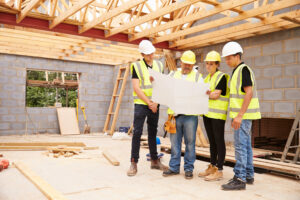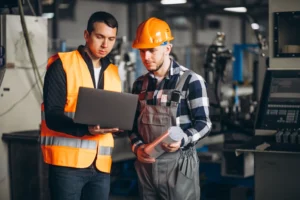
Building the Future: The Intersection of Construction, Technology, and AI
The fusion of construction, technology, and artificial intelligence (AI) heralds a new era in how we envision, design, and erect the structures around us. This trio is not just altering the landscape of the built environment but is also redefining the boundaries of what’s possible. In this article, we delve deep into this intersection, examining how it propels us towards a future where buildings are smarter, construction processes are greener, and projects are completed faster, safer, and with greater efficiency.
The Evolution of Construction
Technology’s Role in Modern Building Techniques
Gone are the days of reliance solely on manual labor and traditional building methods. Today, technology infuses every layer of construction, from sophisticated software for design to automated machinery that lays bricks. This shift not only accelerates project timelines but also enhances precision and reliability.
AI: Transforming Project Management
AI is revolutionizing project management by providing predictive insights, optimizing resource allocation, and facilitating better decision-making. Through machine learning algorithms, AI can forecast project delays, budget overruns, and even suggest mitigative actions, ensuring projects stay on track.
Emerging Technologies in Construction
Drones and Robotics
Drones and robotics are at the forefront of transforming construction sites, offering unparalleled views and access. Drones conduct site surveys and inspections with ease, while robotics assist in tasks ranging from welding to laying bricks, elevating both safety and productivity.
3D Printing and Sustainable Materials
3D printing is pushing the boundaries of construction, enabling the creation of complex structures with reduced material waste. Coupled with the use of sustainable materials, it paves the way for more eco-friendly construction practices.
AI in Construction: An Overview
Data Analytics and Machine Learning
Data analytics and machine learning are the backbones of AI’s application in construction. They analyze vast amounts of data from various sources to uncover patterns and insights, aiding in everything from design optimization to operational efficiency.
AI-Powered Design and Planning Tools
AI-powered tools are revolutionizing design and planning, enabling architects and engineers to explore a wider range of design scenarios and optimize for both aesthetics and functionality. These tools can simulate environments, predict the performance of materials, and even ensure compliance with regulations.
The Impact of Technology on Construction Safety
Wearable Tech and Safety
Wearable technology is enhancing on-site safety by monitoring workers’ health and environmental conditions, alerting them to potential hazards, and even tracking their location to ensure they are safe.
AI for Risk Assessment and Management
AI is instrumental in identifying potential safety risks before they become issues. By analyzing data from past projects and real-time inputs, AI systems can predict where accidents are more likely to occur and suggest preventative measures.
Efficiency and Productivity Enhancements
Automated Machinery and Equipment
Automation in construction equipment, from excavators to bulldozers, is increasing efficiency and reducing the need for human intervention in dangerous tasks, thus speeding up construction processes and improving safety.
Software Solutions for Project Management
Project management software, integrated with AI, is streamlining the planning, execution, and monitoring of construction projects. These solutions offer real-time collaboration, tracking, and reporting features that keep projects aligned and stakeholders informed.
Sustainable Construction Practices
Green Building and Eco-friendly Materials
The construction industry is increasingly focusing on sustainability, using green building techniques and eco-friendly materials that reduce environmental impact and improve building efficiency.
Energy Efficiency through AI
AI plays a crucial role in enhancing energy efficiency in buildings, from intelligent HVAC systems that learn and adapt to occupancy patterns, to smart lighting systems that adjust based on natural light availability.
Challenges and Solutions
Addressing the Skills Gap
As technology evolves, so does the need for a workforce skilled in these new tools and methodologies. Addressing this skills gap through education, training, and workforce development is critical for the future.
Integration of New Technologies
Integrating new technologies into existing workflows and systems presents challenges, from technical compatibility to user adoption. Solutions lie in phased implementation, training, and change management strategies.
Building the Future: The Intersection of Construction, Technology, and AI
Exploring case studies and real-world applications, this section demonstrates the tangible impacts of this intersection. From skyscrapers that touch the clouds more sustainably and efficiently, to homes that adapt to their inhabitants’ needs, the future of construction is here.
The Role of IoT in Smart Construction
Connectivity and Real-time Data
The Internet of Things (IoT) is transforming construction sites into interconnected ecosystems, where real-time data from sensors and devices drives decision-making and operational efficiency.
IoT for Maintenance and Operations
IoT technologies also play a key role in the maintenance and operations of buildings, enabling predictive maintenance, energy management, and enhanced occupant experiences.
Future Trends and Predictions
Augmented Reality and Virtual Reality
AR and VR technologies are set to further revolutionize the construction industry, offering immersive design experiences, enhanced training, and the ability to visualize projects in context before breaking ground.
The Role of Blockchain in Construction
Blockchain technology promises to improve transparency, security, and efficiency in construction project management, from smart contracts that automate agreements to secure, tamper-proof records of all transactions.
The Economic Impact of Advanced Construction Technologies
Job Creation and Market Growth
The adoption of new technologies is not only streamlining construction processes but also creating new job opportunities and contributing to market growth.
Cost Reduction and Investment Opportunities
Advanced technologies offer significant cost savings through improved efficiency, waste reduction, and streamlined supply chains, attracting investment into the sector.
Education and Training for the Future
Upskilling the Workforce
The future of construction requires a workforce skilled in new technologies and methodologies. Ongoing education and training programs are essential to prepare workers for the future.
Academic Programs and Online Courses
Academic institutions and online platforms are developing programs specifically designed to equip the next generation of construction professionals with the skills they need to thrive in a technology-driven world.
The Global Perspective
International Collaboration and Standards
Global collaboration and the development of international standards are crucial for harmonizing practices, sharing knowledge, and ensuring the widespread adoption of innovative technologies.
Conclusion
The intersection of construction, technology, and AI is not just about building structures; it’s about reimagining the future of our physical world. As we continue to innovate and integrate these transformative technologies, we pave the way for smarter, safer, and more sustainable construction practices that will shape our environment for generations to come. This journey towards building the future is filled with challenges, but the potential rewards for our society, economy, and planet are immense.
FAQs
- How is AI changing the construction industry? AI is revolutionizing the construction industry by enhancing efficiency, improving safety through predictive analytics, and enabling smarter decision-making with data-driven insights.
- What are the benefits of using drones and robotics in construction? Drones and robotics increase precision, accelerate project timelines, and improve worker safety by performing tasks in hazardous environments and inaccessible locations.
- Can 3D printing really revolutionize building designs? Yes, 3D printing allows for more complex and customized building designs, reduces waste and material costs, and significantly speeds up the construction process.
- How can construction companies adopt sustainable practices effectively? Construction companies can adopt sustainable practices by integrating green technologies, using eco-friendly materials, and employing AI for energy-efficient building designs.
- What future technologies are poised to impact the construction industry the most? Augmented reality (AR), virtual reality (VR), and blockchain are poised to have significant impacts by enhancing visualization, improving project management, and ensuring transparency and security in transactions.




